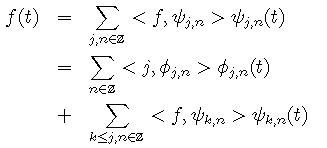Let us recall that a multiresolution approximation is a nested sequence of linear spaces. The orthogonal complement Wj of Vj in Vj-1 can be thus defined:
Then there is a function y such that the family yj,n(t) = 2-j/2 y(2-jt-n), n in Z, is an orthonormal basis of Wj. The family yj,n, j in Z and n in Z, is an orthonormal basis of L2 and
y is an orthogonal wavelet associated to the multiresolution approximation. A signal f in L2 can be decomposed as

where f is an orthogonal scaling function of the multiresolution.
A theorem by Mallat and Meyer builds an orthogonal wavelet from a scaling function.
Here is a cubic spline scaling function and the corresponding cubic spline Battle-Lemarié wavelet, and their Fourier transform. The wavelet is a cubic spline because it is a linear combination of cubic splines.
The wavelet is not compactly supported.
Wavelet bases are bases of L2(R). There are several methods to transform them into wavelet bases over an interval. Once discretized, they are used to process finite signals.
There are several methods to build wavelet bases on functional spaces in dimension greater than 1. The simplest ones uses separable wavelets.